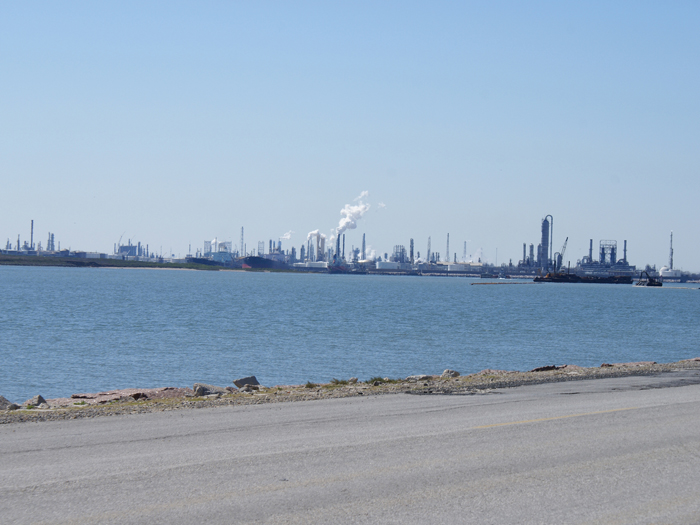What Chemical Industry Risk Managers Can Teach Other Sectors About Their Climate Change Response Plans

On October first, a state judge in Houston acquitted the U.S. arm of French chemical maker Arkema, as well as two executives, of criminal recklessness in a fire and chemical release at the company’s plant in Crosby, TX in 2017. Then, Hurricane Harvey poured more than four feet of rain on the area, flooding the plant that made organic peroxides.
The fire burned for days, forcing a local evacuation and injuring 21 people.
The trial was notable for several reasons: For one thing, it was a criminal prosecution rather than the more common civil or administrative action. Also, major incidents involving toxic releases from refineries and chemical plants have been significantly reduced in the last few years, because the industry has invested in risk management and hardening its facilities.
That is not to say that heavy storms no longer unleash a toxic aftermath. Even as industrial sites are more resistant, rapidly changing flood profiles and drainage patterns are responsible for increased environmental hazards from commercial, municipal and residential sources.
“After Hurricane Harvey, there were emissions from a superfund site,” said Marcel Ricciardelli, senior vice president of Allied World North America environmental and design professional divisions.
“In the southeast and other areas, there have been problems with hog-waste pits and wastewater-treatment facilities overflowing,” he said.
The toxic brew can come from pipelines, human or industrial wastewater, storage tanks, and junkyards.
“The high-profile events seem to attract more litigation, and we have tracked an uptick in true toxic-tort action by plaintiffs’ counsel, not just environmental cleanup cases,” Ricciardelli added.

Marcel Ricciardelli, senior vice president of environmental, design, professional and surety, Allied World
That complicates the coverage and claims dynamic, especially along the U.S. Gulf Coast.
As this story was being written, Hurricane Delta was bearing down on Louisiana, expected to make landfall roughly where Hurricane Laura did just six weeks earlier. Notably, that storm caused widespread outages at the refineries and chemical plants around Lake Charles — because of power outages, not because of any significant damage to the facilities.
Even if there is no toxic event due to damage from the storm, there can be increased pollution.
“As plants go into their procedure for shutting down, especially if it is an emergency shutdown, they are allowed under most emissions rules to release large amounts of pollutants,” Ricciardelli said, “so the air quality drops immediately in advance of a storm. Moving material around the plant is part of the hardening of the facility.”
There has definitely been a focused effort on the part of industry, according to Katherine D. Klosowski, vice president and general manager of natural hazards and structural engineering at FM Global.
“The chemical industry has taken very seriously the huge consequences of damage or leaks, more so than some other industries,” she said.
She noted, “Our clients have taken steps to harden against both wind and flood, whether that is creating a perimeter barrier, or elevating [critical components], or designing roofs and tall structures for wind load. Quite often there is a unique vulnerability at each facility, particularly power.”
Where’s the Generator?
Indeed power was the Achilles heel at Arkema. The Crosby plant was in compliance and had a detailed risk management plan that was followed.
The investigation by the U.S. Chemical Safety & Hazard Investigation Board found that the chink in the armor was the plant’s reliance on an emergency generator that was at ground level, not elevated. When flooding disabled that generator, there was no way for operators to keep the peroxides cool enough to prevent combustion.
“In our experience, the larger facilities do tend to do a better job,” said Toby Smith, president of Ironshore E&S’s environmental group, part of Liberty Mutual.
“We have seen a big oil terminal hit by a Category 5 hurricane, but because of its preparedness and the quality of its assets, there was no environmental release. With planning and committed funding, industry can protect itself,” Smith explained.
That said, he added, “We have seen where smaller insureds have great plans that gather dust on the shelf. We write a lot of middle-market chemical companies and have a risk engineering staff that works with them to help implement their plans.”
That implementation extends beyond the fence line.
“We encourage joint training with the local fire departments,” said Smith.
“That way [responders] know where the water is and where to spray it, or not.”
Knowing What to Do and When
Collaborative response drills and training are common in heavy industrial areas. For example, along the Houston Ship Channel — the chemical capital of the hemisphere — the municipal fire departments and each plants’ fire brigade are part of the Channel Industries Mutual Aid.
As has often been noted by industry and fire officials, the fastest way to turn a $1-million fire into a $30-million environmental incident is to spray water on something that should just be secured and allowed to burn itself out.
Even when local utilities and alternate power sources are part of the planning, changes on the ground and in the atmosphere are a challenge for modeling.
“We call in a hydrologist to assess and update our own flood mapping and topography,” Klosowski said.
Flood mapping is premised on historical data.
“To create new maps is difficult [so] underwriters’ reliance on flood maps has diminished in the last few years. There is nothing new and shiny to point to, just an acknowledgement of exposure in any particular geography,” said Mary Ann Susavidge, chief underwriting officer for the North American environmental group of AXA XL.
Ricciardelli at Allied World asked, “Is a 100-year-flood map still valuable, even if it was just revised a few years ago? The situation does take a deeper dive into mapping, because flooding patterns are changing so quickly.”
That swings back to the differentiation between large and small facilities.
“Even a small blending facility with non-reactive agents has to have a robust plan,” said Ricciardelli.

Toby Smith, president, Ironshore
“Maybe the operators of a scrap yard do not feel that they can afford environmental insurance, but whether or not we write them would be because of their risk management procedures.”
He also noted a risk as seemingly innocuous as a giant pile of used tires — of which have caught fire and burned for weeks, creating a huge environmental problem.
Ricciardelli also noted that regulation and enforcement has shifted from the federal level to the state level in the last four years.
That can complicate corporate-level underwriting for companies that have operations in different states with widely varying standards.
“We have seen more impoundment problems,” Susavidge said.
“In a storm or flooding, it can be difficult to trace a pollutant when it has moved. Proximity to homes, and whether water is ponding or dispersing are important factors.”
Where flood waters flow or accumulate is changing as human factors on the ground exacerbate the effects of climate change. As development continues, drainage patterns change.
“Many structures were built with their utilities [high-volume air conditioning, power distribution, heaters, and pumps] in the basement or even sub-basement,” Susavidge said.
“At minimum, water ends up in the hole and then what do you do with that ‘stuff?’ ” she asked rhetorically.
“In worse situations, the water damage, which is a property cover, turns into a mold claim. Mold is usually sublimited to a nominal amount that is not usually sufficient.”
Holes Aren’t Only in the Ground
“In response to the pandemic, hospitals have had to create negative-pressure in patient rooms,” said Klosowski.
“That usually means outfitting windows with fans. As a result of that, we are now seeing a lot of water damage because of those open windows,” Klosowski continued.
“That is driving losses. It is likely a temporary situation, but needs to be addressed. Most likely that would be indirect venting,” which is not necessarily complex or expensive, but is not as simple as a fan in an open window.
Successive storms, as Laura and Delta could be, and as Harvey, Irma, and Maria were in 2017, exacerbate the problem.
“That trio really hamstrung everyone,” Susavidge said.
“We had never seen anything like it. Adjusters were just not able to get out to claims quickly enough. We always advise insureds to give notice if there is a water intrusion. Insureds are anxious about frequent claims, but notice is not a claim.”
Smith noted, “Major storms are always major triggers. We see more claims for water damage and for mold than we do for chemical releases.”
He also stressed the importance of insureds having a connection to restoration services.
“In a major storm, there will be hundreds of firms competing for those services from a limited number of providers,” he added.
“And those providers will be competing for power, labor and equipment. Time is of the essence especially for smaller insureds in smaller areas.” &










